![]()
![]()
![]()
Use LEFT and RIGHT arrow keys to navigate between flashcards;
Use UP and DOWN arrow keys to flip the card;
H to show hint;
A reads text to speech;
47 Cards in this Set
- Front
- Back
|
Timgad, Algeria, High Empire, a new colony that Trajan planed in North Africa
to extend Roman Rule Roman's doing well. |
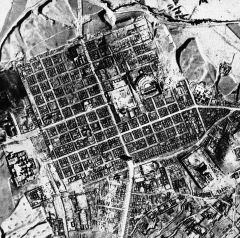
|
|
|
Al-Khazneh, Jordan, high empire, 100 CE
Tomb, carved into a rock wall, very elaborate very dyanamic |
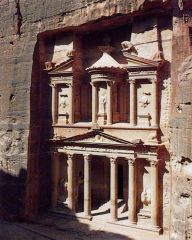
|
|
|
Apollodorus of Damascus, High Empire, 100 CE
Fenestrated sequence of groin vaults, Public market had clerestory and was open which let in air and light like New Kingdom temples, but with more light because the spaced inside was so open arches, because of concrete |
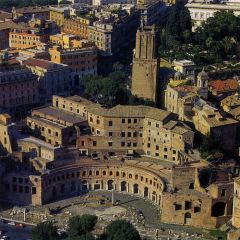
|
|
|
Ara Pacis, 50 bce, Early Empire
Tellus relief at end of imperial procession, surrounded by babies/life, Mother earth figure, fertility naturalism |
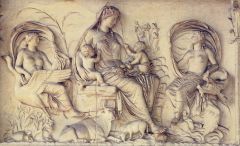
|
|
|
Imperial procession Frieze on Ara pacis, 50 bce, Early Empire,
shows families, adults/kids/women, promotes family values and population growth some of the portraits are very detailed, identifiable low and high relief, very settled in space Tellus, mother earth is at the end of the procession |
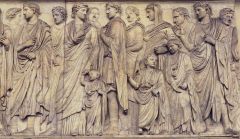
|
|
|
Ara Pacis, 50 bce, Early Empire
Beginning of pax romana, centralizing of power Alter of peace, space inside for honoring Augustus, Frieze all around sides with imperial procession |
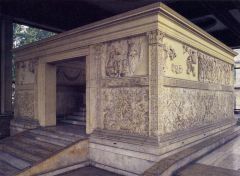
|
|
|
Arch of Constantine, Late Empire, 300 CE
filed with sculpture, 3 arches, commemorates battle of Melvian bridge, which is where he converts, stole lots of reliefs from other emperors' arches, and then re-carved faces to look like him |

|
|
|
Arch of Constantine, Late Empire, 300
Roundels he stole from other kings, SPOLIA, to show that he was superior, they have a more classical style of drama, movement and human form whereas the relief below is more squat like the Christian style to come is |
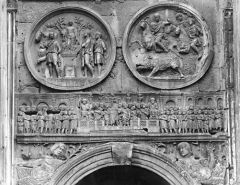
|
|
|
Triumph of Titus, features personifications of honor and valor
being crowned victorious |
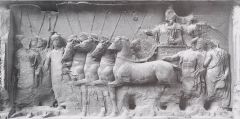
|
|
|
Spoils of Jerusalem, relief in Titus Arch, 50 CE, Early Empire
commemorates victory over Judea, and the spoils taken in triumph from the Jewish Temple in Jerusalem |
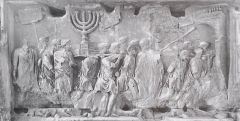
|
|
|
Arch of Titus, 50 CE, Early Empire,
engaged composite (ionic, corinthian) arch After war and battles, people would walk through the arch in victory reliefs on inside commemorate emperor, he is with victory has coffered ceilings which takes some weight off of the arch |
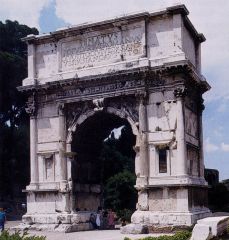
|
|
|
Triumphal arch of Trajan, High Empire, 100 CE
one of his many projects, |

|
|
|
Asiatic Sarcophagus with portrait of a woman, 100 CE, High Empire, clear mix of asian aesthetic because images go all the way around, but depicts Greek gods and goddesses
|
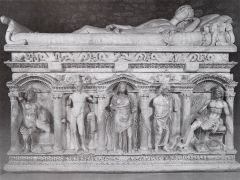
|
|
|
Emperor Augustus, 50 bce, Early Empire
could have been made after death, or while living, idealized, either by others because he was great or by himself because was egotistical. barefoot, supported by signs of athena, mythological scene on his breastplate: thinks he is a god Asserts his divine authority because moving from Republic to Empire takes a ton of power, unstable at first Greatness no longer=old age, wisdom, but youth, muscle, idealization |
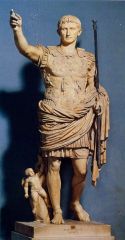
|
|
|
Aula Palatina, Late Empire, 300 CE
|
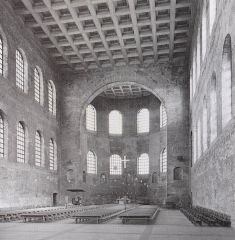
|
|
|
Aula Palatina, Late Empire 300 CE
very simple inside and out, very similar to Early Christian Churches, more so than roman |
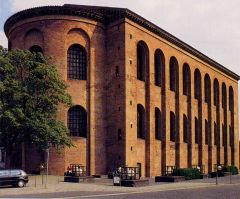
|
|
|
Basilica of Constantine, Late Empire, 300 CE
Fenestrated sequence of groin vaults new basilica (roman court of law) decorated with mosaics, paintings and statues Constantine issued edict of Milan, tolerates christians had a hugggeeee throne here that he would sit on 2 entrances, one faced the throne where he would sit, and the other face the colossal statue of him. |
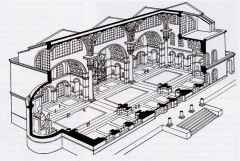
|
|
|
Drawing of Baths of Caracalla, late Empire, 300 ce
|

|
|
|
Baths of Caracalla, Late Empire, 300 ce
hot--->medium--->cold had libraries, lecture halls etc. truly to please the people mosaic tile work everywhere, hugely spacious |
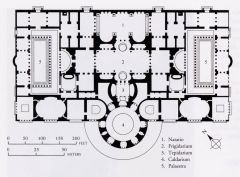
|
|
|
Arch of Constantine Relief, Chariot procession
Late Empire, 300, |

|
|
|
Two Constantinian Coins, Late Empire, 325,
shows the vast array of opinions and depictions of him throughout and after his rule |
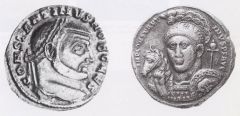
|
|
|
Flavian Amphitheatre, 75 CE, Early Empire,
built after Niro, as a sort of appeasement to the people Doric on bottom, then ionic, then corinthian and then corinthian pilaster (very flat, not fully carved) 80 arches, tons of ways in, each one had barrel vaulted entrance, held 50,000 people, helped bc so many people were unemployed, needed entertainment to keep them happy watched gladiators |
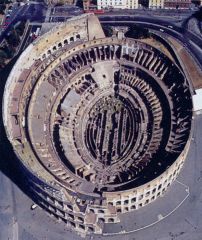
|
|
|
Column of Trajan, High Empire, 100 CE
commemorated his victory in a specific battle, spiraling coninuous narrative all the way to the top his tomb was at bottom column was hollow, stacked marble, had a staircase all the way up From the ground you could only see a few rows up, but you could see the other parts from windows of the taller buildings surrounding it. |

|
|
|
Distribution of Largess, Late Empire, 300 CE
A relief carving from arch of Constantine shows a new, less classical style of form depiction, much more static, chunky, frozen in a moment, no gesture |
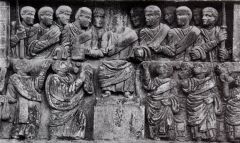
|
|
|
Marcus Aurelius, 175 CE
END OF THE PAX ROMANA less perfected, powerful than Augustus looks weary, knows the empire is struggling there are invasions, the plague, natural disasters his philosophy = stoicism, just endure, stay calm, be determined poetic, philospher type, shown through beard, |
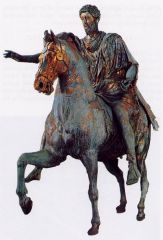
|
|
|
Portrait of a Flavian Woman, Early Empire, 100 CE
focus on modern fashion, idealized beauty of women, not so much the greek goddess ideal |
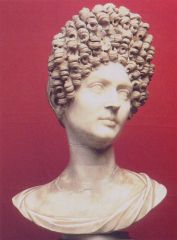
|
|
|
Forum of Trajan, High Empire, 100 CE
complex, enter through big courtyard, equestrian statue in front and triumphal arch, Latin and Greek libraries, court/legal/political buildings Temple was built after his death, |

|
|
|
Baths of Diocletian, the Frigididarium room
clerestory, huge groin vaults, mosaic-ed walls |
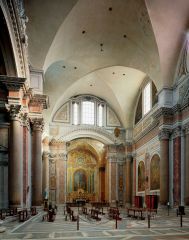
|
|
|
Trebonainus Gallus, Late Empire, 250 CE
Confident, head is small emphasis on his physical force first nude emperor, only wearing sandals showing his brute force |
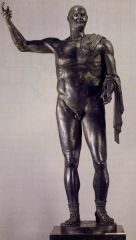
|
|
|
Maisson Caree, 25 CE, Early Empire
psuedo peripteral temple, in corinthian style example of Augustian Neo-Classical Temple style |
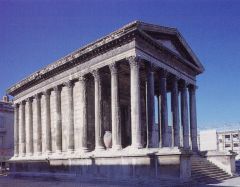
|
|
|
Encaustic Portrait, High Empire, 150 CE
|
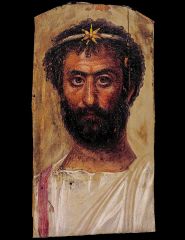
|
|
|
Sea creature mosaiced floor in the baths of Neptuen, 150 CE, High Empire
floor in a bath room decorated by mosaic of neptune being pulled by sea horses, black and white reminiscent of Greek Vases |
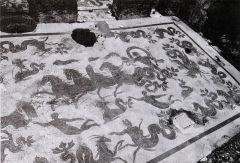
|
|
|
model of more normal houses/apartments for everyday people, 150 CE, High Empire
|
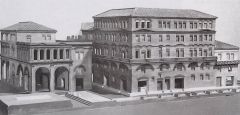
|
|
|
Pantheon, High Empire, 125 CE
built to all gods, very polytheistic and left room for more future gods to be added went along with the ideas of the roman empire, inclusive, helped to keep the conquered people happy From front, looks like typical post and lintel temple, deep etruscan portico, and greek corinthian frieze and pediment but inside=drum, with coffered dome ceiling with occulus, ceiling was gilded Occulus=eye of jupiter, crosses the floor with the sun symbolic for holding all gods, unity/equality |

|
|
|
Pont-Du-Gard, 25 bce, Early Empire
an aqueduct in France, shows the wealth and prosperity of the Roman Empire, Concrete with arches |
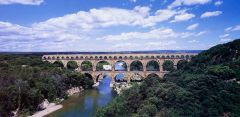
|
|
|
Porta Maggiore, 50 CE, Early Empire
used rough and smooth stones, RUSTICATED style |
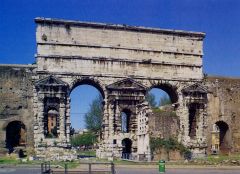
|
|
|
Portrait of Livia, 25 ce, Early Empire,eternal youthfulness, perfect appearance are very similar to greek goddesses
all her portraits had the newest styles, but she looks just as young |
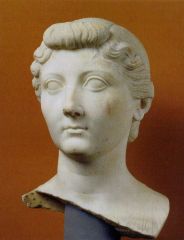
|
|
|
Protrait bust of Trajan Decius, Late Empire, 250 ce
weary, wrinkled with bags under his eyes, this emperor was short-lived and the times were hard, shown in his anxious eyes/expression |
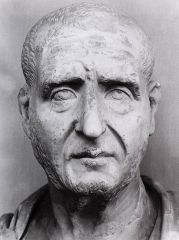
|
|
|
Colossal Statue of Constantine, Late Empire, 325 CE
30 ft tall when seated, was gilded, mostly marble with some wood parts hidden mimicked a famous statue of Zeus, made by Phidias HUGE, Commander, strength, size, super intimidating but also barefoot and divine, Eternally youthful |
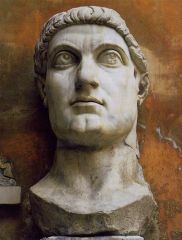
|
|
|
Caracalla 225 CE, Late Empire
Was supposed to look imposing and individual, but ended up looking fearful and upset. |
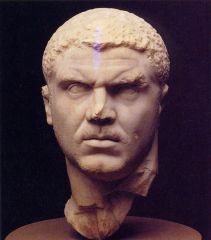
|
|
|
Portrait of Hadrian, 125 BCE, High Empire
first roman emperor to wear a beard, he was often modeled after greek statues because he loved the Greeks Supported the arts, and education |
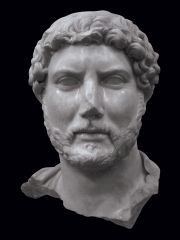
|
|
|
Portrait of a Vespasian ruler,
not idealized like Augustus, shows his power and wisdom he was leader after Nero, Empire needed assurance that we wasn't impulsive, but wise |
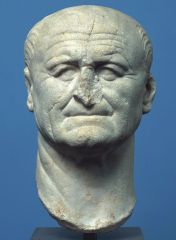
|
|
|
portrait of severus and his family
|
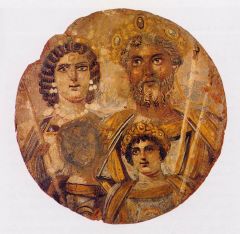
|
|
|
The Golden House of Nero, 50 CE,
super extravagant summer home for bad emperor |
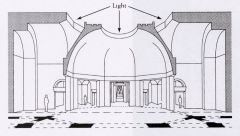
|
|
|
Portrait of Vespasian, 75 CE, Early Empire
old, not idealized like Augustus, emphasizing his power/wisdom like in Republic He was emperor after Nero (who was awful), so he needed to show that he was wise and not impulsive was built after his death |
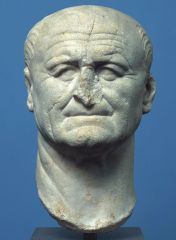
|
|
|
Sarcophagus of a philosopher, Late Empire, 275CE
like most sarcophagi at this time, deceased shown as a philosopher, a way to cope with insecurities of state of country, |
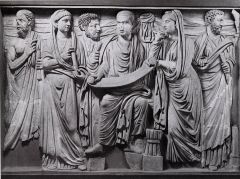
|
|
|
Temple of Venus, Late Empire, 250 CE
complete departure from classical architecture, almost a direct critique of the pantheon, scalloping, weird arch pediment, etc. |
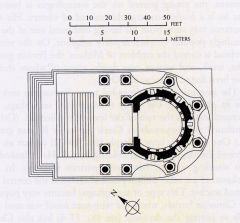
|

